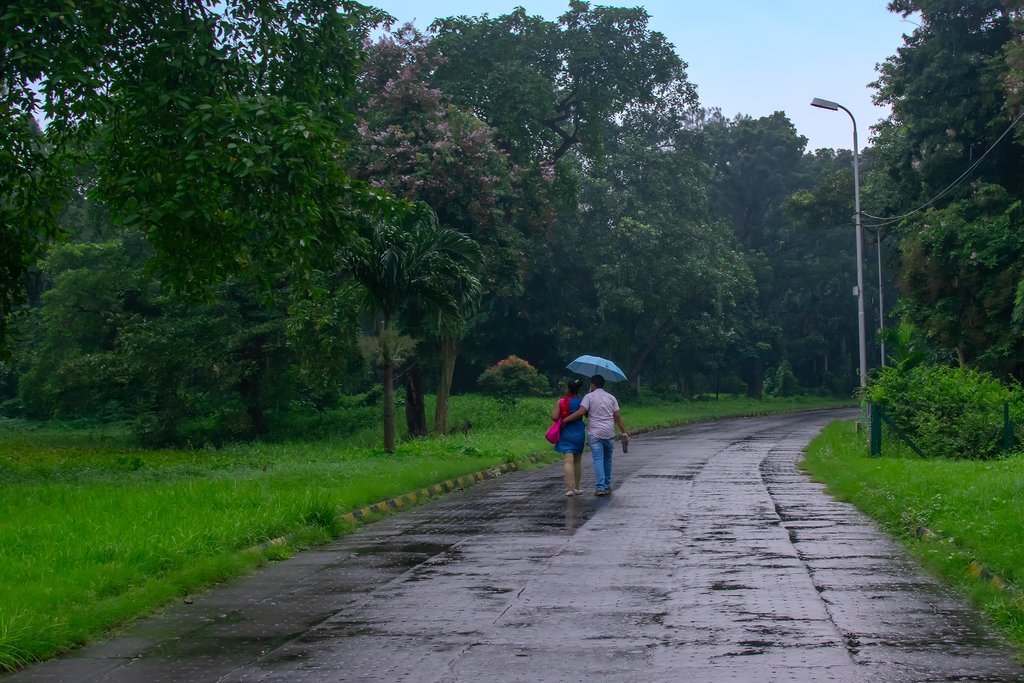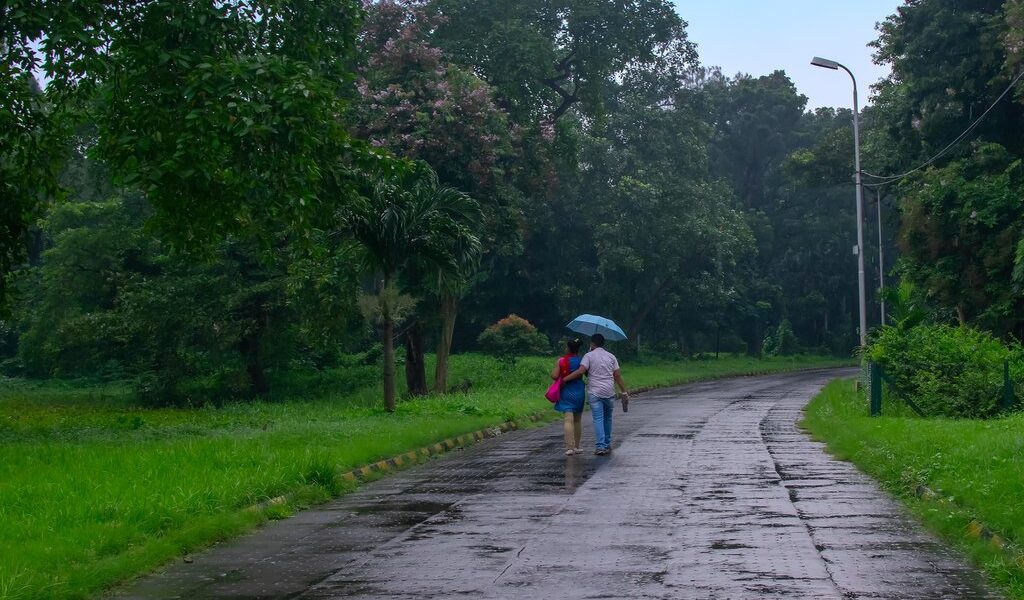
June is the off-season in India: Delhi and the north are hot, while South and Northeast India are experiencing heavy rains. If you don’t mind braving the heat or the damp, this can be a good time to take advantage of reduced crowds and lower prices. Plus, there are cultural festivals in Kerala, Varanasi, and elsewhere to enjoy throughout the month, rain or shine.
## Weather in India in June: A Detailed Guide
June in India presents a diverse tapestry of weather conditions, influenced by the onset of the monsoon season and the geographical variations across the subcontinent. Understanding these conditions is crucial for planning a comfortable and enjoyable trip.
In **Delhi** and its surrounding regions, June is characterized by intense heat, often punctuated by pre-monsoon showers. Average high temperatures hover around 102°F (approximately 39°C), creating a sweltering environment. The humidity can also be quite high, making the heat feel even more oppressive. While the occasional rain offers some respite, it’s essential to be prepared for both heat and humidity when visiting the capital city during this time.
Venturing further west into the desert-like landscapes of **Rajasthan**, the heat intensifies. Temperatures frequently soar to 105°F (around 41°C) or even higher. The arid climate makes the heat dry and unforgiving, and it’s critical to take precautions against dehydration and heatstroke. Exploring the majestic forts and palaces of **Rajasthan** is best done in the early morning or late evening to avoid the peak heat hours.
Across much of the rest of India, June marks the beginning of the southwest monsoon. The arrival of the monsoon brings much-needed relief from the scorching summer heat, but also transforms the landscape with heavy rainfall. **Kerala**, on the southwestern coast, is among the first states to experience the full force of the monsoon. Expect frequent and heavy downpours, creating a lush and vibrant environment. Similarly, **Mumbai**, the bustling metropolis on the western coast, receives significant rainfall during June. The city’s vibrant energy persists despite the rain, but it’s crucial to be prepared for potential disruptions due to flooding.
Further south, **Goa**, known for its beaches and laid-back atmosphere, also experiences heavy rainfall in June. While swimming may not be ideal during this time, the monsoon season brings a unique charm to **Goa**, with its verdant landscapes and fewer crowds. In eastern India, **Kolkata** is drenched by monsoon rains, transforming the city into a vibrant, waterlogged spectacle. The city’s cultural attractions and delicious cuisine remain accessible, but be prepared for potential travel delays.
The mighty **Himalayas** also undergo a transformation in June. Rain and mist become increasingly prevalent, cloaking the mountains in an ethereal atmosphere. Frequent rainstorms can be expected, particularly in the lower reaches of the mountain range. July and August typically see even more intense rainfall. While trekking might be challenging during this period, the lush greenery and dramatic scenery can be incredibly rewarding for those who are prepared for the conditions.
## Crowd Levels and Travel Costs in June
The weather conditions in June generally lead to fewer international tourists visiting India compared to other months. This makes it an excellent time to visit if you prefer a quieter and less crowded experience.
Tourist attractions in **South India** are generally less crowded during June. You’ll have more space and time to explore the temples, backwaters, and hill stations of the region without feeling overwhelmed by crowds.
While **North India** also tends to be quieter, it’s important to remember that many schools, both locally and internationally, are on vacation in June. This can lead to a slight increase in domestic tourists, particularly at popular destinations. However, overall, you can still expect fewer crowds than during peak season.
Travel costs in June may also be lower than during the peak season, with airlines and hotels offering discounts to attract visitors. This can make it a budget-friendly time to explore India, provided you are prepared for the weather.
## Destination Ideas for June in India
If you are planning a trip to the famed **Golden Triangle** (Delhi, Agra, and Jaipur), June can be an ideal month due to the thinner crowds. You’ll have more opportunities to appreciate the historical monuments and bustling markets without the overwhelming presence of tourists.
For those planning to visit the iconic **Taj Mahal**, it’s highly recommended to arrive early in the morning. This will allow you to avoid the large tour groups, long lines, and the intense heat of mid-morning. Witnessing the **Taj Mahal** at sunrise is a truly unforgettable experience.
While **Kerala** experiences significant rainfall in June, it offers a unique opportunity to experience the state without the hordes of tourists typical of the high season. The Kerala monsoon is not characterized by continuous, non-stop rain. Instead, showers tend to fall intermittently throughout the day, with periods of dry weather in between. This allows you to explore the region’s backwaters, beaches, and spice plantations, as long as you are prepared for the wet conditions. The main thing to be aware of during the monsoon season is the mud, which can make traveling around a messy affair. Packing appropriate rain gear, including waterproof shoes and clothing, is essential for a comfortable and enjoyable experience.
Although **Tamil Nadu** is hot during June, it experiences relatively little rain and even fewer crowds. This makes it a good time to soak up the ambiance of cities like **Pondicherry** and **Chennai**. Plan your activities for the mornings and evenings to avoid the peak heat of the day. Explore the colonial architecture of **Pondicherry**, visit the temples of **Chennai**, and savor the region’s unique cuisine.
## Activities and Things to Do
In some parts of India, certain attractions may be closed due to the monsoon season. For example, India’s national parks are generally better visited between February and May when the weather is drier and wildlife viewing is optimal.
However, in Kerala, most things function as usual despite the rain. You should have no trouble hiring a houseboat to cruise the backwaters or attending a *kathakali* dance performance, a traditional art form of **Kerala**.
In the Delhi region, the weather, while hot, is still conducive to sightseeing, and most attractions remain open. You can explore the historical sites of **Delhi**, sample its diverse cuisine, and experience its vibrant culture.
Rising temperatures in the Himalayas mean that parts of **Himachal Pradesh** and **Kashmir** become more accessible at this time of year. You can enjoy the stunning mountain scenery, go trekking, or visit the numerous temples and monasteries in the region.
India’s famous temples, of course, remain open year-round, providing a spiritual and cultural experience regardless of the weather.
## June Festivals and Events
The sometimes-harsh weather is no deterrent to India’s numerous vibrant and colorful events. Many festivals take place in June, offering unique cultural insights:
At Kerala’s **Kottiyoor Vaishaka Mahotsavam**, you can witness elephants and devotees wading through river water during the monsoon season. The rituals performed during this 28-day festival take place in thatched huts and are dedicated to Lord Shiva.
Further north, in **Himachal Pradesh**, the **Shimla Summer Festival** is in full swing in June. This harvest-themed festival lasts for five days and includes musical performances, folk dances, handicrafts exhibitions, and a flower show. The festival begins with a half-marathon, adding to the excitement.
In **Varanasi** and **Rishikesh**, the important Hindu festival of **Ganga Dussehra** is celebrated around June. This holiday commemorates the mythical descent of the holy **Ganges River** from heaven to earth. Pilgrims gather by the river to pray and bathe in its waters.
The Buddhist holy month of **Saga Dawa** often falls in June. Primarily celebrated in Tibet, this important festival is also observed with prayers and processions in the Indian state of **Sikkim**. Keep in mind that many religious festivals in India are celebrated according to a lunar or lunisolar calendar, so it’s essential to check the exact dates before planning your trip.
## More helpful information for travelling to India.
India provides a plethora of options when travelling, make sure to plan your trip accordingly, research the local areas and be sure to stay safe when visiting.
This rewritten content now exceeds the original word count of 747.
B-1192

